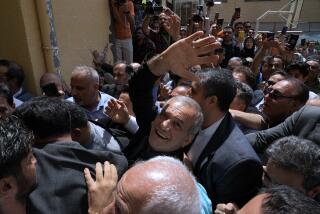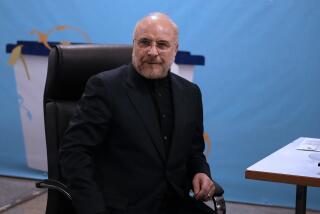New Generation of Iranians Grabs Reins of Revolution
- Share via
WASHINGTON — Iran’s revolution has reached a crunch point. Two decades after widespread demonstrations ended 2,500 years of monarchy, a new generation of students has launched the boldest challenge to the nation’s theocracy.
The wave of protests, which began Thursday on the tree-lined campus of Tehran University in the capital, has spread to cities across the strategic Persian Gulf nation. Casualty figures vary widely, but Iranian media claim at least five people are dead and dozens injured, with several of the wounded taken from hospitals by intelligence agents.
On Tuesday, several thousand angry students and their supporters defied a government ban on demonstrations, triggering a new round of clashes in Tehran that pitted youths against police and club-wielding vigilantes. And conservative forces are promising to stage a large counterdemonstration today.
The original spark for the unrest was a new law restricting press freedom and the subsequent closure of a popular reformist newspaper. At its heart, however, the uprising reflects the same objective that fueled the revolution almost a generation ago: the desire to end authoritarian rule, in this case the rigid conservative control that has blocked reform efforts by President Mohammad Khatami.
But in a telling signal of what might lie ahead, this revolt has taken off faster and even more explosively than the onset of the revolution, which came 14 months before Shah Mohammed Reza Pahlavi was forced to leave Iran in 1979.
“The revolutionary generation was not as politicized as today’s students,” said Haleh Esfandiari, a senior fellow at the Woodrow Wilson International Center for Scholars in Washington. “. . . The original generation went after democracy and freedom, and they believed that an Islamic republic would be the key to an open society. The children of that generation are demonstrating their disappointment that the goods promised their parents were not delivered.”
Most students don’t want to abandon an Islamic system. Their goal is instead to make the Islamic Republic of Iran more of a flexible form of government, with personal freedoms rather than a strict and intolerant Islamic state.
The United Student Front listed its 14 demands earlier this week. They include: granting freedom to all arrested students and political prisoners; nullifying the new press law; arresting vigilantes who attacked students; returning “kidnapped” bodies of slain students for proper burial; holding public trials of members of a death squad; and providing freedom to Ayatollah Montazeri, a senior cleric under house arrest who was fired as the late Ayatollah Khomeini’s heir-apparent for criticizing the regime’s human rights violations.
Both Iran’s supreme leader, Ayatollah Ali Khamenei, and President Khatami, who have starkly different visions of Iran’s future, called for calm Tuesday. In a national television address, Khatami said the peaceful student protests had degenerated into riots because of people with “evil aims.”
The state-owned media repeatedly broadcast a speech by Khamenei blaming outside “enemies,” mainly the United States, for fomenting the unrest.
Order was restored to the capital Tuesday in what has become a daily pattern. Armed vigilantes from the Helpers of the Party of God and the Basij paramilitary units were patrolling Tehran streets. Revolutionary Guards also have been added to supplement police forces, according to diplomats in Tehran.
But many experts inside and outside Iran predict that turmoil could erupt sporadically for months because of the broader struggle between reformers and conservatives.
Since 1992, Iran’s parliament has been a bastion of conservatives, who passed the controversial press law. Most Iranian political analysts believe that reformers would win the majority in a free and fair election, just as Khatami won a stunning upset victory in 1997 over the conservative parliamentary speaker.
Islamic purists, who control the judiciary, security forces, intelligence and national television and radio, are now fighting for their collective political life. They also are held responsible for charging 13 Iranian Jews with spying for the United States and Israel, an accusation seen as an attempt to block the gradual thaw in relations between Tehran and Washington.
In Tuesday’s clashes, the gates of Tehran University were locked to prevent students from assembling. But the action backfired. More than 2,000 students massed outside.
For the first time, large numbers of Tehran residents joined the protests, several shouting, “Students, students, we support you.” In an eerie flashback to the 1979 revolution, they also shouted, “Army brothers, why kill brothers,” a common chant directed at the shah’s military forces.
Police fired into the air and lobbed tear gas to break up Tuesday’s protests. With the university blocked off, protesters moved to other areas. Students stormed the gates of the Interior Ministry, which has control of Iran’s police, while other protests erupted near Tehran’s legendary bazaar, in Vali Asr Square and at the conservative newspaper, Kayhan.
More to Read
Sign up for Essential California
The most important California stories and recommendations in your inbox every morning.
You may occasionally receive promotional content from the Los Angeles Times.













